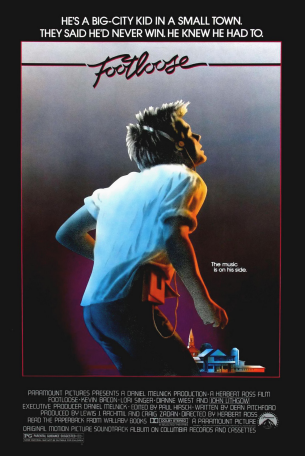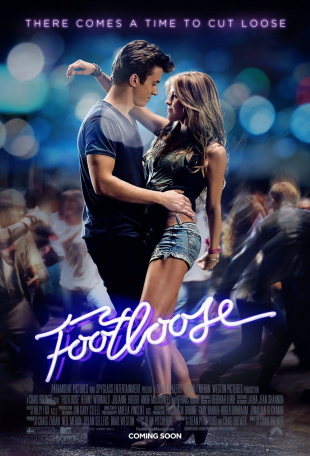By Amy Van Veen (The Cascade) – Email
Print Edition: November 2, 2011
 Remakes, adaptations and based-on films are nothing new to our generation. They may feel a bit like a violation – specifically when they take a classic we know and love and try to make it “new” or “fresh” or whatever other adjective that makes movie producers swoon. But the fact of the matter is there are only a few stories out there and sometimes it is better if a movie just admits upfront that it’s the same instead of trying to make something new and cheating audiences out of feigned originality.
Remakes, adaptations and based-on films are nothing new to our generation. They may feel a bit like a violation – specifically when they take a classic we know and love and try to make it “new” or “fresh” or whatever other adjective that makes movie producers swoon. But the fact of the matter is there are only a few stories out there and sometimes it is better if a movie just admits upfront that it’s the same instead of trying to make something new and cheating audiences out of feigned originality.
Remakes have been happening for decades, one classic example is You’ve Got Mail. It’s a Hanks/Ryan classic from 1998, but that film was based on another one starring Jimmy Stewart in 1940 called Shop Around the Corner which was a film based on a play from Hungary called Parfumerie from 1937. Any new remakes we have now are usually remakes of old movies, which can often be traced back to plays, musicals or books. She’s All That is the new My Fair Lady which was the new Pygmalion, so the trend is there and no matter how much audiences squawk, they’re going to happen.
It’s with some trepidation, then, that I go on to compare Footloose from 1984 and Footloose from 2011. The plot itself was tweaked only slightly, as were the costumes and most of the dialogue. The real comparison, then, is in the characters.
 First and foremost is Ren McCormack, the catalyst for Bomont finding a new rhythm (being corny is allowed here since corny is actually this movie’s main character). Kevin Bacon played the original Ren with his feathered hair, Bowie tie and angry punch-dancing skills. In that role – which could be argued to be the peak of his career – Bacon created a quintessential character that both Bret McKenzie and Andy Samberg have paid homage to. However, one thing needs to be settled: Bacon looks like the forgotten love child between Miss Piggy and Skeletor. When he kisses the preacher’s daughter after she gives him her Bible and his scary Gollum hands creepily lay limp behind her head? Terrifying. Absolutely terrifying. Unknown Kenny Wormald, on the other hand, has mastered the feathered hairstyle that doesn’t look like someone sat on it and even though his supposed Boston accent doesn’t come out until after his angry dance, he doesn’t incite the same fear as Bacon. Unfortunately, though, his continually pursed lips conjure images of dancing Olsen twins more than a gymnast rebel in West Virginia.
First and foremost is Ren McCormack, the catalyst for Bomont finding a new rhythm (being corny is allowed here since corny is actually this movie’s main character). Kevin Bacon played the original Ren with his feathered hair, Bowie tie and angry punch-dancing skills. In that role – which could be argued to be the peak of his career – Bacon created a quintessential character that both Bret McKenzie and Andy Samberg have paid homage to. However, one thing needs to be settled: Bacon looks like the forgotten love child between Miss Piggy and Skeletor. When he kisses the preacher’s daughter after she gives him her Bible and his scary Gollum hands creepily lay limp behind her head? Terrifying. Absolutely terrifying. Unknown Kenny Wormald, on the other hand, has mastered the feathered hairstyle that doesn’t look like someone sat on it and even though his supposed Boston accent doesn’t come out until after his angry dance, he doesn’t incite the same fear as Bacon. Unfortunately, though, his continually pursed lips conjure images of dancing Olsen twins more than a gymnast rebel in West Virginia.
The preacher’s daughter, Ariel, could be considered the other main character, but in both versions she seems more like a means to an end. Rebel new kid needs a love interest whose family situation also ties back to the car accident that started this whole mess in the first place. In 1984 the role was filled by Lori Singer (don’t worry, she’s still an unknown) who made the sweet-girl-gone-bad look more like sweet-girl-gone-mad. I don’t know if she meant to play the girl certifiably insane, but it definitely came across as such. Julianne Hough, Ryan Seacrest’s latest squeeze, plays the new preacher’s daughter who manages to up the skank factor in the film all on her own. A dance movie made now is obviously going to have the quintessential rebel-girl look down pat, but despite her more honest performance, I prefer the alarmingly tight jeans of 1984 to the denim cut-offs that were trying to be Daisy Duke but reminded me of Tobias Funke.
The preacher, himself, is a character that I would argue to be of greater importance than Miss Ariel and no matter how hard I try to accept Dennis Quaid as the new town dad, John Lithgow will always have a special place in my heart. That fire-and-brimstone demeanour mixed with that indistinguishable accent, along with that halo-like receding hairline? Sorry, Quaid. Maybe you could run away with your brother.
Now, obviously Ren McCormack is the hotshot of the town. He’s got the VW Bug, he’s got the feathered hair, and he’s got that adorable smile. But what about Willard? Adorable Willard with his sunglasses sitting on the brim of his trucker hat and his unfortunately camouflaged wardrobe. What about him? He can’t dance and then he learns how through one of the greatest montages set to one of the greatest montage songs. “Let’s hear it for the boy,” indeed. Let’s hear it for Willard. As much as I love new Willard, though, old Willard had the innocence and unibrow that could make even Sarah Jessica Parker swoon.
On the bad boy side of things, there is a noticeable switch between 1984 and 2011. In 1984, Ren McCormack was the scary looking one and Chuck was pretty adorable – despite his tendency to beat his girlfriend. In the 2011 version, though, Chuck and his entourage of redneck, bus-driving, scruff-faced white trash played a starkly unattractive contrast to the perfectly-coiffed Ren McCormack with his Crest-commercial winning smile.
The tale of the moustachioed man needs to be addressed, as well. There seems to be a certain facial hair code that is adhered to for both the old and the new films. If a man has a full head of hair and a full Ron Swanson-esque moustache, he is one to be trusted. If, however, a man has a Ron Swanson-esque ‘stache and a balding head that he tries to hide with the not-at-all-subtle comb-over strategy, he is not a man to be trusted. In 1984, Uncle Wes, a comb-over, moustachioed man, was in the latter category. He believed the town’s view of his nephew, he saw the worst in Ren and he blamed him for everything going wrong in the town. The 2011 Uncle Wes, though, has quite a different character role in the movie. With a full head and face of hair, this Unkey fills the role that the 1984’s mother did: he believes in Ren, he stashes Quiet Riot albums and he defends him against Reverend Moore’s judgmental tone. This later uncle is not the only example of the trusted facial hair man, both the flour mill owner in the old one and the cotton gin owner in the new one sport moustaches and both of them help the prom happen. Thanks to these trusting upper lips the kids of Bomont find a place to prove themselves trustworthy and dance their way to confetti glory with that quintessential flying V formation that would put the Mighty Ducks to shame.
Since it is a dance movie, though, there needs to be some discussion on each of these films in regards to dancing. Both films share very similar scenes: dancing at the drive-in (though the new one features more of a dance-off and less of a solo show for Chuck), dancing at the bar out of town, dancing in the warehouse, dancing with Willard, and dancing at prom, but when the dancing starts in the new one, it’s focused less on Ren McCormack and more on the spectacle of the scene itself. One prime example would be the bar dancing scene. In 1984, it was a dark, smoky room with close-up shots of the individual dancers and an unimpressed Willard, but in 2011, the entire scene shows off “country linedancing – a white man’s wet dream,” as Ren explained to Willard, making the shots not about one or two dancers, but about the dance itself.
While I did enjoy the new one, the old one needs to be experienced first and treasured before the latest can be appreciated as a shot-for-shot remake with slightly better hair and slightly disappointing music (namely the slowed down version of Bonnie Tyler’s “I Need a Hero”). Whether 1984 or 2011, as soon as Kenny Loggins’ version of “Footloose” comes on, I can’t help but move my feet along with that quintessential opening scene of toe-tapping and heel-clicking glory.


